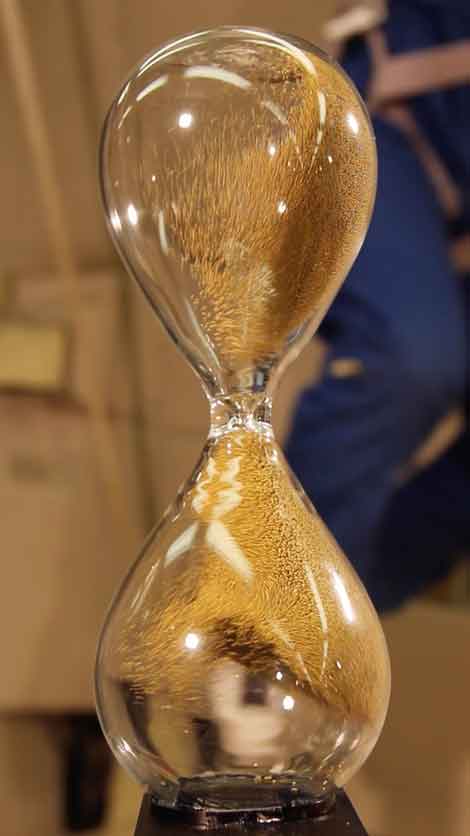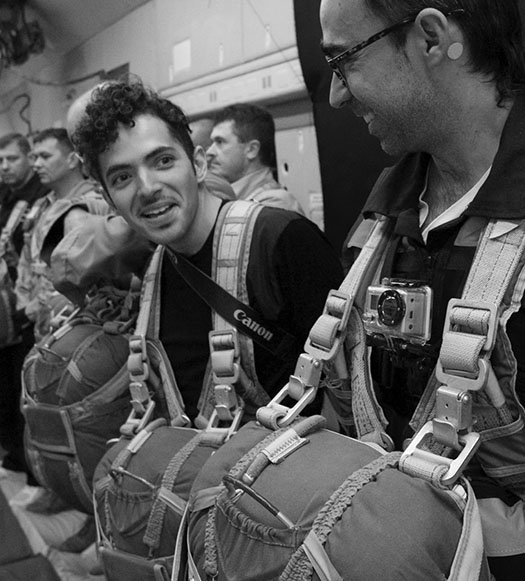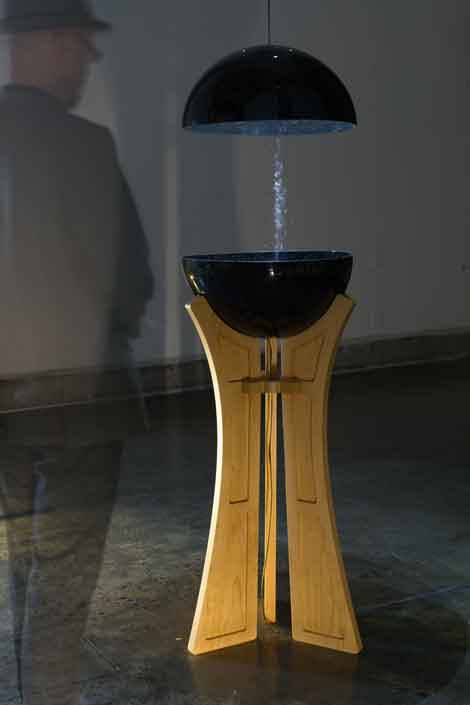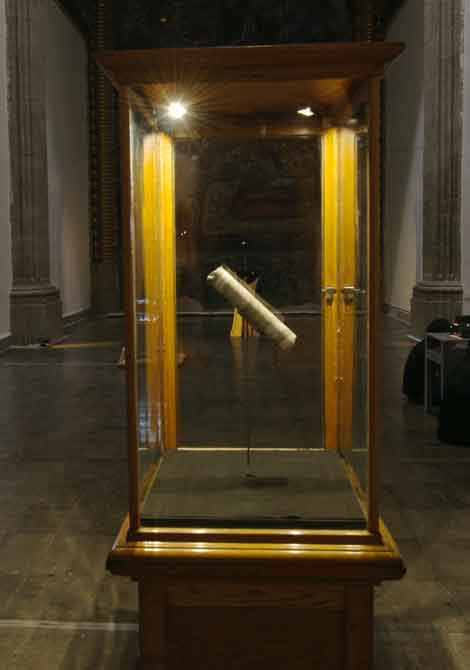Prestidigitator, composer, engineer and conceptual artist Nahum hails from Mexico City, has lived in London for many years after a degree from Goldsmith’s College, but really, he belongs anywhere. Recently he and eight other Mexican artists, along with a Mexican scientist, spent a day floating above our planet in zero gravity on a parabolic flight. Russians flying the huge Ilyushin 76 MDK aircraft lifted them into the stratosphere in order for them to make an astounding number of conceptual artworks in the span of a few hours. The Russians had never seen anything like it. These weren’t the first artists on their plane, but the first Mexicans, yes, which has brought to Space Art a welcome new perspective.
On board: 50 cameras, a core sample from the north of Mexico, a large hourglass with Mexican sand, and—among other props says Nahum—“a piñata shaped like a star filled with Mexican candies and confetti.” The artists did not get to smash it however, as the forces of such impacts in zero gravity are violent, and it actually would be quite dangerous. So, a Russian commander “exploded” the star, and the glitter, confetti and candies, like a Felix Gonzalez-Torres piece in Heaven, floated free throughout the cabin. Nahum says the Russians loved them, but were less thrilled with the detritus they spent weeks cleaning out of their plane.
Some artists on the flight made two to three pieces. All are in a traveling exhibition currently on view at the Laboratorio Arte Alameda, an arts complex associated with the Museo de Bellas Artes in Mexico City. “La Gravedad de los Asuntos (Matters of Gravity)” will travel from Mexico to Moscow at the end of March; then to Slovenia in July; to El Paso, Texas in November; and will finish the tour in São Paolo in March 2016.
Artillery: Nahum, what did you want to achieve with this zero gravity flight in terms of art?
Nahum: The intentions of the project were to explore gravity, this universal force on the planet that has shaped us, and everything we know here, by changing our perspective on it through its absence.
Can you give some examples of the works in the show?
One artist, Armas, took a core sample [from the north of Mexico where she’s from] into the plane and freed the earth layers from thousands of years of history. Ale de la Puente explored time and gravity using a huge hourglass with sand. In zero gravity, time wasn’t flowing as it does normally here; it flows all over the place. She was reflecting on the links between time, space, and gravity because gravity shapes space-time.
So ideas like speed are displaced in that environment—time is literally suspended. Can you give another example?
Iván Puig made a piece with seven scales, each with a book that has changed a paradigm in history: among them Darwin’s On the Origin of Species, Marx’s Das Kapital, the Mexican constitution, and the Bible. We say “el peso de la historia,” the weight of history—it’s the same idiom in Spanish and in English.
Give us a summation of the entire show, if you can.
The point of the entire project is how much we have culturally appropriated the idea of gravity to express so many things. “Gravity” in terms of meaning that carries more weight or things like “I am falling in love.” You can see how a physical force really informs a way of understanding not only the physical world but also the cultural and emotional realms.
Is this part of what you proposed to the Russians? Did you have these ideas articulated?
Yes. We did not want to do science—we are not scientists—what we wanted to do was create new ways to perceive and understand something, which was gravity.
How is this different from other art/science projects?
This was opening the discussion about how gravity, a physical force, really has a conversation with culture. The pieces are very conceptual. But in order to undertake them, we needed to experiment, to be in zero gravity, to change our perspective, and in order to do that, we needed a space mission, a zero gravity flight.
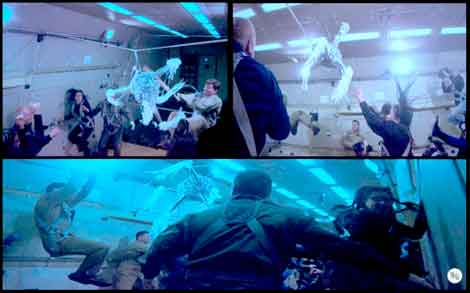
Mexican space artists in the Ilyushin 76 MDKaircraft with “exploding star” piñata. Installation view at El Laboratorio Arte Alameda. Photo: Adrián Cuevas.
There was a scientist on your flight, Dr. Miguel Acubierre, who studies gravitational waves. Were there any artists that used science as a basis for the artwork?
Arcángelo Constantini was exploring speculative aspects of science. Lately he’s obsessed with the molecule of water and its memory. There is something called the Schumann Resonance—our planet has a certain resonance [relating to Earth’s electromagnetic field]. But since we have introduced global communications, it has changed the planet and its resonance, its life. Arcángelo asks us to consider how important the properties of [Earth’s] water are. The process was very scientific, but the results were poetical.
Okay, let’s talk about your work.
The concept was very simple. The piece comes from [wanting] to show the emotional side of humans when they are in extreme environments, alien environments, to show that we are still the same people that need affection and love.
How did you come to this work?
I was very influenced by once when I was talking to an astronaut, and we were talking about feelings, he told me that in some cases astronauts are under contract and they cannot talk about certain feelings when they are in space. And I thought, well that’s rubbish! Of course, when they are in the space world they are like superheroes, but I wanted to see the emotional side of that. Also, with this project, it was so difficult to get to that point of being in zero gravity, I wanted everyone to stop focusing on switching on the camera or doing their own experiment, and change that into focusing on the ‘other’.
Describe for us how you made such a piece on your flight.
So the piece is a series of embraces. When you have two bodies in zero gravity that try to touch each other and have that human physical contact, it also becomes a different thing because first you are floating and it’s like, how do I get there? You cannot swim, so you really struggle to grab the other person. And someone is upside down and another is in a funny position, so a hug becomes something else. And once you manage to grab someone, you notice that the body of the other person does not have any weight. It’s like holding onto air. You get very anxious about that, and you try to hold on more. And this becomes a beautiful action.
How does this look in the gallery installation?
I made a video installation of three channels with these massive screens seven meters by five meters tall. I wanted to use the aesthetics of a music video, because music videos really enhance the emotions and they make things really dramatic. I was looking for that as well—real cinema, real space-love cinema. I composed some music, some romantic music, and then you have all these people struggling to hug each other, and then they go apart, and all the faces and the happiness, and the love. People are very touched by that. So it was about humanizing space as well. That’s my piece.
I know that for many years you organized the massive London underground club in Victoria Station called The Shunt. Now you work with the UK-based Arts Catalyst on events like KOSMICA, a hugely popular space-art festival in Mexico City and London. But I understand that in 2014 you were also honored with the “Young Space Leader” award by the International Astronautical Federation. You told me you had just turned 35 years old.
Yes. What made the IAF award special is that it is the first time they gave the award to an artist, and also the first time to a Mexican.
What are some of the space-related activities you’ve done leading up to this award?
I coordinate the committee for ITACCUS [focused on cultural uses of space], which is chaired by Roger Malina [son of JPL founder Frank Malina] and Nicola Truscott [founder of the Arts Catalyst]. Since we set it up back in 2008, we have been struggling to find our place in the space community. We have been concerned about certain topics—women in space exploration, and highlighting the relevance of societies that don’t have the context of a space race, in other words those without big space agencies and space projects but still engaging in an international discourse about space exploration. It’s important that we are also listening to them.

Left to right: Juan José Díaz Infante, Tania Candiani, Andreas P. Bergweiler, Miguel Alcubierre, Gilberto Esparza, Marcela Armas, Iván Puig, Ale de la Puente, Fabiola Torres-Alzaga, Arcángelo Constantini, Nahum. Photo: courtesy Nahum.
How does KOSMICA also reflect this mission?
KOSMICA is a space and culture event held in different countries. It’s an interface where we can have a conversation about things that would otherwise be too radical or conceptual. To show people that they can engage in space activities even if they don’t have a rocket—they can still be part of it. It’s about humanizing space, bringing it closer to people.
So scientists and engineers—space people—see you doing all of this and still finding time to make art!
I think the IAF really liked all this work, so I was humbled and surprised to get the award.
Thanks for Skyping with us and good luck with the show!
Nice to see you, Carrie!


